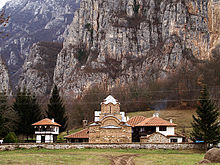Poganovo Monastery
The Poganovo Monastery ( Cyrillic Манастир Поганово ) is now a Serbian Orthodox monastery located in southeastern Serbia . The women's monastery is dedicated to St. Jovan Bogoslov (to German Apostle John ). The monastery is located in a side valley of the Jerma River , about one kilometer south of the border town of Dimitrovgrad and not far from the Bulgarian border.
history
Prince Konstantin Dragaš, who had the monastery built at the end of the 14th century, is considered to be the founder ( ktitor ) of the monastery . After the death of Konstantin Dragaš, after the battle of Rovine , his daughter Helena Paliologos , wife of the Byzantine emperor Manuel II Palaiologos , took over the supervision of the monastery. From 1871 the monastery was administered and renewed by the Bulgarian Church until Bulgaria had to cede the so-called Bulgarian Western Territories to Serbia in 1919. In 1895 the Bulgarian writer Aleko Konstantinov described the monastery and the area.
architecture
The monastery church is a simple cross-dome type with trikonchos and narthex dome, an early building of the Morava school or the Tarnowo school and was built after 1371. The facade is designed with the ornamental building decor characteristic of the style of the Palai Renaissance .
The ground plan and elevation of the single-nave cross-domed churches of Poganovo correspond to the architecture of the simple foundations of the Balkan peninsula in the middle and second half of the 14th century in the style of the Morava school . (Other typical predecessors of single-nave cross-domed churches but without the trikonchos can also be found in the school of Tarnowo , the cross-domed churches in the empire of Tsar Stefan Dušan (especially Sv. Nikola in the Archangel monastery ) and the Marko Kraljevićs Markov Manastir Foundation ). The unplastered stone building of the monastery church has a lively plastic effect due to the variable design of its components, which is also underlined by a square tower over the vestibule ( narthex ) as the highest component and an eight-walled drum-like dome .
The brick belts, which were still cautiously used in Poganovo, placed between hewn limestones, are typical elements of the Byzantine architecture of the 14th century, characterized by an exuberant joy in playful ornamentation in the facade design. The simple ornamental design of the facade of the monastery church, however , lags far behind the complex, simultaneous foundations in Morava Serbia , Thessaloniki or the older churches of Nessebar in terms of scope and sophistication .
Frescoes
Inside there are frescoes from the decoration of the church from 1499. The resemblance of the painting to the Kremikowzi Monastery , about 60 km to the east, is associated with the same master by some researchers. However, the different shapes and the lighting design speak for other artists. The composition "The betrayal of Judas " is nothing new, but no other work in Bulgarian painting from this period shows a representation of the same theme with so many realistically understood and reproduced movements. Figures like Jesus Christ and Judas in this picture could also come from painters of the Italian Renaissance . The portrayal of Saint Ivan Rilski is characteristic of the Bulgarian wall painting.
Icons
Several famous icons are known from the monastery, but the most famous is that of the "Madonna with St. John the Evangelist" (also known as Poganowo icon today) resulting in the collection of icons in the crypt of the Alexander Nevsky Cathedral in Sofia is located . A copy of the icon can be found inside the church.
literature
- Bissera V. Pentcheva: Imagined Images: Visions of Salvation and Intercession in a Double-Sided Icon from Poganovo (PDF; 141 kB) in Dumbarton Oaks Papers 54 (2000), 139–153 .; The Double-Sided Icon from Poganovo (images) (PDF; 1.38 MB)
- Aleksandar Deroko (Serbian Александар Дероко): Монументална и декоративна архитектура у средњевековној Србији. (Monumental and decorative architecture in Serbia). Belgrade 1985.
- Gerhard Ecker: Bulgaria. Art monuments from four millennia from the Thracians to the present . DuMont Buchverlag, Cologne 1984
- Chr. Walter: The Iconography of the Prophet Habakkuk In: Revue des études byzantines , T. 47, 1989, pp. 251-260
Web links
- Poganowo Monastery - Additional information (multilingual)
Individual evidence
- ↑ Alexo Konstantinow: What? Switzerland …? ( Какво? Швейцария ли?… ). SLOVO ( СЛОВОТО ), 2011, accessed February 27, 2011 (Bulgarian).
Coordinates: 42 ° 58 ′ 47 " N , 22 ° 38 ′ 15" E


